- Author Matthew Elmers [email protected].
- Public 2023-12-16 21:49.
- Last modified 2025-01-24 09:17.

The following abbreviations are used in the article: A - field army, AK - army corps, IN - military district, Gra - Army Group, CA - Red Army, mk (md) - motorized corps (division), pd - infantry division, RM - intelligence materials, RO - intelligence department of the headquarters of the military, RU - Intelligence Directorate of the General Staff of the Spacecraft, TGr - tank group, mk (td) - tank corps (division).
In the previous part, the RM was considered about the headquarters of the corps, which came to the leadership of the Soviet Union and the spacecraft in 1941. The reliability of these RMs again proved to be unsatisfactory. At the end of May, there were seven microns on the territory of East Prussia and former Poland. None of them were discovered by intelligence. Before the start of the war, there were ten of these corps, and again not one of them was discovered by intelligence …
Intelligence only regularly reported the presence of AK, but this information, for the most part, turned out to be unreliable. The reconnaissance also did not discover the fact of the redeployment of the headquarters of the corps, TGr, armies and GRA (fronts) closer to the border. In the final part, we will consider the RM, which entered the RO of border districts from radio intelligence.
Radio intelligence knew everything
A version appeared that radio intelligence supplied only reliable information before the war. The radio intelligence officers allegedly knew the handwriting of all German radio operators and could determine the belonging of radio stations to specific formations or formations.
It should be noted that the OSNAZ radio battalions stationed at the border were subordinate to the RO of the VO headquarters and therefore their information was included in the RO reports. Consequently, there could not have been some important materials that passed by the RO and allegedly ended up in the secret archives of the RU.
The analysis of the information given in report No. 1 of the RU from 22.6.41 and in the memoirs of the former head of the RU coincide with the RM (reports of RU from 31.5.41 and 15.6.41), which were received three weeks before the start of the war and were published. This can only indicate that no other ("sensational") materials do not exist in the archives.
According to the author, the absence of other published RM RU for June 1941 (until June 22) is due to the fact that our intelligence was unable to adequately detect the movement of the headquarters and troops of the invasion group directly to the border. This made it possible to blame the executed generals for the tragic events of June 22, 1941, and after the death of I. V. Stalin - and himself.
Radio intelligence on the completeness of intelligence information
Lieutenant General P. S. Shmyrev served in radio intelligence for 50 years, and 15 of them headed this service. Pyotr Spiridonovich provided the author of the book "The Golden Ear of Military Intelligence" with documents and materials and presented them to his colleagues.
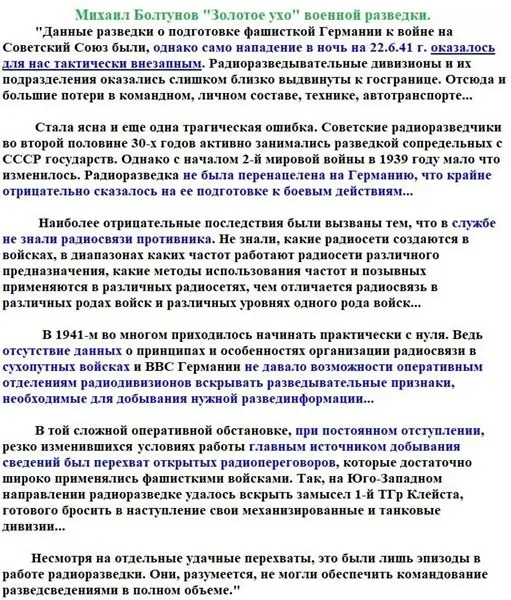
The book notes that the attack on June 22 was tactically surprise for the spacecraft and this is from the words of radio intelligence officers, who, according to a fictitious version, were obliged to know about the German troops' withdrawal to their initial positions. Before the war, radio intelligence officers could only record: on what wave, approximately from which settlement, German radio stations were communicating. By the strength of the signal, they judged how large the radio stations were used. Subscribers in other localities were also registered. They tried to identify the main and subordinate radio stations by radio broadcasts. According to intelligence information about the locations of the headquarters, they also tried to determine the subordination of the radio networks of the headquarters to each other. If the RM of agent intelligence were incorrect, then the conclusions about the ownership of radio networks to specific headquarters of German troops also turned out to be unreliable.
There is not a word in the book that Stalin and the "traitor-generals" did not listen to the reliable information received from radio intelligence. Therefore, there was no such information. Also in the book there is no mention of the detection at the border by the radio intelligence of the headquarters of the German GRA, TGR and MK, and even more so about the intercepted signal "Dortmund". Only captured German documents in the initial period of the war made it possible to move from the technical characteristics of enemy radio stations to the comprehension of operational information.
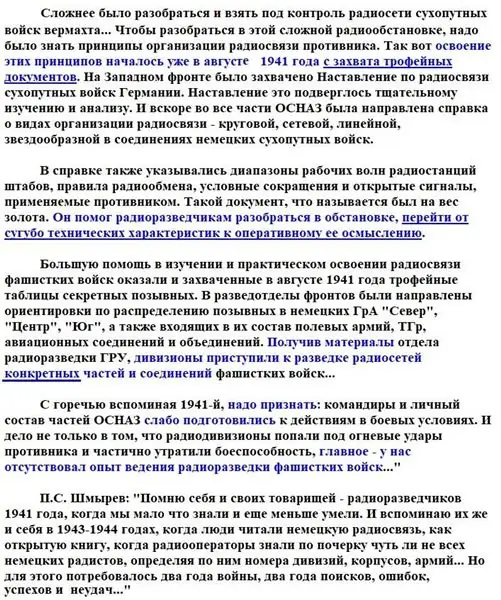
Most of our military knew about the inevitability of war with Nazi Germany, but tactically, the attack on June 22 was unexpected. A. K. Bushuev:
In September 1940, I was assigned to the 394 hordes [separate radio division KOVO. - Approx. auth.] OSNAZ head of the peripheral radio direction-finding point … He intercepted and direction finding the working radio stations of the German army in a given sector … Radio interception and direction finding materials were delivered to the headquarters [ord. - Approx. auth.] courier by rail … Apparently, we [command. - Approx. auth.] knew about the danger from the Germans in general, so to speak, strategically, and tactically - that the war was beyond the threshold - did not know …
21.6.41 radio direction-finding point was taken to the exercises to the border in the area of Lyubych Rud. According to the site on radio intelligence, the point was deployed two kilometers from the border. The arriving battalion commander expressed dissatisfaction with the chosen position, located too close to the border. At dawn on June 22, Lieutenant Bushuev arrived at the post office in Lyubocha Ruda to report to the commander of the hordes about the selected new position. Here he was caught by the beginning of the war. The point at this time is still at the border. The personnel of the point, with the exception of Lieutenant Bushuev with a driver and five killed servicemen, were taken prisoner along with all their equipment. The commander of the 394th Horde is at his apartment on the morning of June 22 and unexpectedly wakes up to the sound of exploding bombs. Is it possible, based on this fact, to state that the radio intelligence officers knew about the beginning of the war at dawn on June 22?
There are similar recollections of the head of the radio direction-finding point of the 474th horde of ZAPOVO:
The evening of June 21 passed as usual. The personnel, except for the shift on duty, lay down to rest, and I went to an apartment in the village of Rymachi 1.5 km from the radio station. I woke up suddenly on June 22, sat up in bed and saw earth and glass on the blanket …
On a site dedicated to radio intelligence, it says:
In the period from 23 to 26 June according to the data open radio interception scouts of the 394th horde the presence of the 1st TGr near the border was established Kleist in the 16th TD, 63rd and 79th MD, which were moving in the direction of Sokal and Krystynopl …
Probably it was not possible to find out about the rest of the TGr troops from open negotiations. It should be noted that the 63rd and 79th MD were not in the Wehrmacht. Consider a summary of RU from 28.6.41:
Documents captured in battle during the defeat of the headquarters of the 39th military corps reveal the enemy's operational intentions for actions on our Western Front. Installedthat in the Vilenskoye direction there is 3 Army enemy, in the Brest direction - 2 Army … The strike group of the 3rd Army, consisting of 39 military corps, 5 AK led an offensive at the junction of the north-western and western fronts, and in the morning of June 25th, part of the 3rd Army from the Vilno area turned to Minsk for action on the rear of the Western Front …
Only a week after the start of the war, our intelligence was able to obtain the first information about the 2nd and 3rd TGrs, which are called armies in the summary. According to the 3rd TGr, even on June 28, the intelligence does not know about the presence of the 57th MK (12 and 19 TD, 18 MD) and the subordinate of the 6th AK. It turns out that writers "know" more than radio intelligence officers … Nothing is said about full command of the situation in the book about naval radio intelligence.

Radio intelligence materials
In the published materials there is little information about the information received from radio intelligence before the start of the war. Therefore, it is difficult to verify the reliability of these RMs, but let's try. The first mention of radio intelligence data dates back to 2.10.40. Probably, this information was obtained from open negotiations.
RU summary: [122 km south-west of Warsaw - author's note]
Again we are faced with two exact designations of the front and the area where they are expected to be found. And again 100% disinformation. 1st pd 13.9.40 headed for East Prussia and has already settled in Konigsberg. The 178th PD never existed. There can be no talk of the 78th front line, which is located in the West. The radio intelligence provided by RM resembles the situation with fake signs on the shoulder straps of the German military. Only now the German command is also using radio air …
The next mention of radio intelligence is available in summary of RO KOVO (20.5.41):
According to reliable data radio intelligence and RO OdVO, the deployment of the following units and formations is confirmed: Bacau - headquarters of the 4th army, Craiova - headquarters of 1 AK, Brasov - headquarters of 6 AK, Buzau - headquarters of 5 AK, Tecuch - headquarters of 3 AK, Piatra Neamt - headquarters of the mountain rifle corps, Slatina - headquarters 11 pd …
Information about the deployment of the headquarters of the Romanian army was received from the RO's agent sources, and radio messages intercepted by radio intelligence were tied to the locations of the headquarters.
Continuation of the summary:
Radio intelligence data confirm the delivery of building materials to the border with the USSR. For the period from 30.4. 10 wagons of cement arrived at Tirgu-Frumos by 2.5. From 21.3 to 17.4 at the station 3 km south. Iasi imported 46 890 kg of round and square iron. 10 thousand beech and oak sleepers were sent to the station Piatra Neamt …
The same data at the end of April established an increased movement of military echelons in the area of Braila, Bacau, Roman, Pashkani, Iasi … According to radio intelligence, air masters and radiotelegraphists from the commercial aviation are enrolled in the Air Force … According to radio intelligence, 27.4 at Braila station [30 km from the Soviet-Romanian border. - Approx. auth.] the German motorized part was unloaded …
It is very likely that these RMs were also obtained from open negotiations. The place of unloading of the German motorized unit is doubtful, since there were no German motorized or tank units on the territory of Northern Dobrudja and Moldavia before the start of the war. However, the intelligence service of the RU and the border troops of the NKVD has repeatedly confirmed their presence in a significant number …
Since the beginning of April, undercover intelligence has provided overestimated information about the presence of German troops in the border Romanian territories (summary RU from 4.4.41): By 22.6.41 it was already said about the presence of up to 16 divisions (including up to 2 TD and 6 MD), but also these RMs were not refuted by radio intelligence. Let's analyze the only published summary, which contains detailed information that came from radio intelligence.
Special message of the RO of the headquarters of PribOVO (5.6.41):
Radio intelligence data: German military field radio stations on the territory of East Prussia continued to operate in the following radio networks: a) Radio Network of the Main Command - Berlin; subordinates: Konigsberg, Danzig, Stettin, Poznan, Breslau.
The radio intelligence officers were only able to identify the main radio station in Berlin and the subordinate radio stations without indicating the designation of the headquarters. During this period, the headquarters of the 18th A, 8th AK and 1st VO are deployed in Konigsberg. With which of these subscribers was radio communication maintained? The radio intelligence officers do not know this and therefore do not indicate it. It can be assumed that we are talking about the headquarters of the 18th A.
In Danzig there is the headquarters of the 20th Military District, and a little to the east, in the city of Elbeng, the command of the Group of Armed Forces "Sever" is located, which neither radio intelligence nor intelligence agents could find before the start of the war. This is probably why, when Danzig is mentioned, then we should talk about radio communication with GRA "Sever".
There are no large headquarters in Stettin except the headquarters of the 2nd Military District. What should be the radio communications from Berlin with this headquarters? It is impossible to find out. The only thing that comes to mind is sea airfields and air observation points located on the coast.
Radio communication with Poznan and Breslau is communication with the command of the GRA "Center" and "South", which were also not detected by our intelligence.
Continuation of special message
The radio network of the army grouping of East Prussia. Main Konigsberg; subordinates: Insterburg, Ortelsburg. The radio stations in Letzen and Stallupenen are not marked in operation …
The message refers to the army radio network. Our intelligence knows that the headquarters of the 18th A is located in Konigsberg. Therefore, it should be a matter of negotiations between the headquarters of the 18th A and the subordinate headquarters. The radio intelligence materials do not answer the question: what radio networks are we talking about? Either the 18th A with subordinate corps, or the 8th AK with subordinate divisions, or the 1st Military District with subordinate commandant's offices?
Undercover intelligence is confident that the headquarters of the 12th AK is located in Insterburg. The headquarters of the 5th AK relocated from Belgium appears in Ortelsburg from 14.4.41. The headquarters of this corps was never subordinated to the 18th A. What could be discussed between the headquarters of a foreign army and the headquarters of the AK subordinate to the 9th A? The author would suggest that negotiations were registered with the headquarters of the 4th TGR, which was stationed near Allenstein. There were no other formations or formations subordinate to 18th A in this area.
In the city of Letzen, according to the RM reconnaissance, there is an AK headquarters, and in Stallupenen - the 214th Infantry Regiment. In fact, since April 1941, the headquarters of the 26th Infantry Division, which in May 1941 was subordinate to the 38th AK, has been deployed in Letzen. The corps headquarters is located southwest of Konigsberg. It is possible that these networks were discovered by radio intelligence.
Since May 1941, not far from the town of Stallupenen, the headquarters of the 121st Infantry Division, subordinate to the 2nd AK (headquarters - Gumbinen), has been deployed. The 2nd AK until mid-April 1941 was subordinate to the 18th A, and from April 22 - to the headquarters of the 9th A.
Continuation of special message:.
Since March 1941 (possibly even earlier), the 12th and 7th AK (the mention of it will be a little lower) are subordinate to the 4th A and kept in touch with its headquarters. Therefore, they did not need to talk to the headquarters of the 12th and 7th AK with the headquarters of a foreign army.
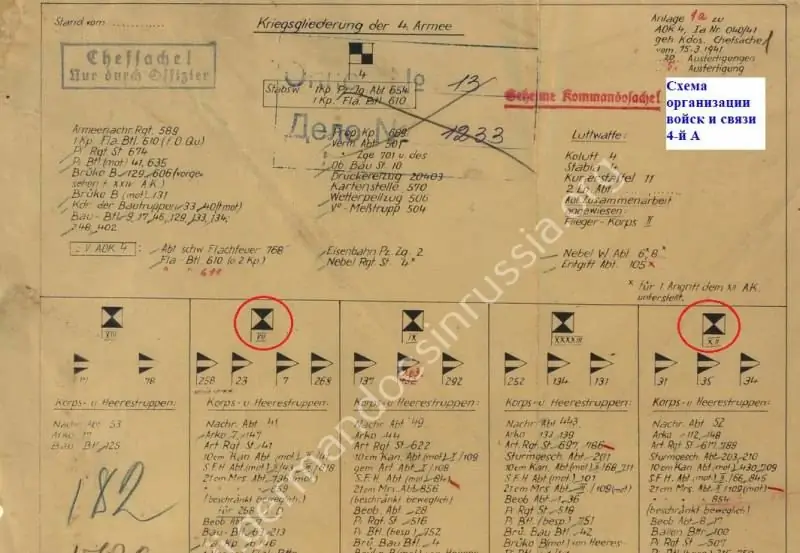
The problem was that the radio network of the 12th AK could not be present in the town of Insterburg. the headquarters of this corps from December 1940 to the end of April 1941 was in the city of Gnesen. In May 1941, he was relocated to Radom, and in early June he was ordered to go to the border in Biala Podlaska. It is not known who exactly the agents and radio intelligence took for the headquarters of the 12th AK in Insterburg … We can only say that the exact and rechecked RM turned out to be disinformation. One of two conclusions suggests itself: either the German command was playing a radio game on the air, or radio intelligence could not provide anything except data on radio networks …
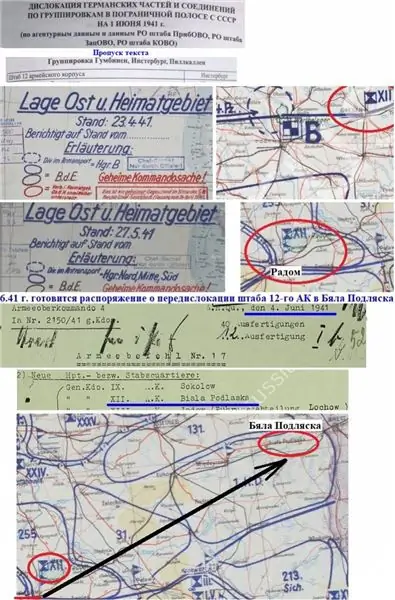
Continuation of special message:.
According to intelligence, the headquarters of the 20th Army Corps is deployed in Danzig, which is confused with the headquarters of the 20th Military District. The 285th security divisions are deployed near Khoitse, and the 207th security divisions are stationed near Kosiezhin. The headquarters of the GRA "Sever" is located in Elbing. Presumably, we are talking about the connection of a certain headquarters, subordinate to the rear protection service of the GRA "Sever", with subordinate divisions.
Continuation of special message:.
The radio network, which was mistaken for the network of the corps grouping, is actually the headquarters of the 2nd Military District. Subordinate radio stations: Neustattin, Stralsund and Schlup are commandant's offices (of a large number), which are subordinate to the 2nd VO. Neustattin is also home to the headquarters of the security forces and the commander of the rear area GRA "North" (R. H. G. 101). Again, the radio intelligence data does not say anything about the true designations of the subscribers.
Continuation of special message:.
According to intelligence, the headquarters of the 7th AK is located in Tilsit. The headquarters of the 7th AK from the end of April until 16.6.41 is deployed near Warsaw in Zegrze. The indication of him in the RM as of 1.6.41, as well as the alleged presence of a communications battalion of the 7th AK can only indicate disinformation slipped by the German command.
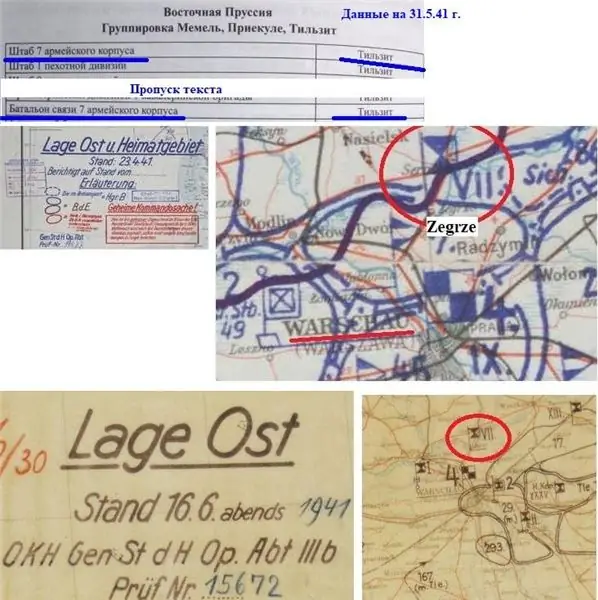
Whom are our intelligence and radio intelligence so confidently tracking in Tilsit? In fact, since the end of April, the headquarters of the 26th AK is located in Tilsit, which is subordinate to the 18th A. In Shilute, the headquarters of the 61st Infantry Division from the 26th AK is located. Again we are faced with a pattern: as soon as accurate and rechecked data appears in the Republic of Moldova, indicating the number of a unit or headquarters, in the overwhelming majority of cases it turns out to be disinformation …
Continuation of special message:.
As mentioned above, the headquarters of the 26th Infantry Division is located in Letzen. Not far from it are the headquarters of the 9th A and the advance group of the headquarters of the 3rd TGr. It is possible that one of the two specified subscribers was mistaken for a radio station in Letzen.
Slave radio station in Allenstein. Near Allenstein there is the headquarters of the 39th MK (from the 3rd TGr), the headquarters of the 41st MK (from the 4th TGr) and the 403rd Security Division, subordinate to the 9th A. Who talked to whom and what radio stations meant radio intelligence officers is not clear …
The city of Angerburg belongs to the area of responsibility of the 16th A and the headquarters or units (from the division and above) could not be tied to this city - they are not there.
The headquarters of the 6th Infantry Division from the 6th Army Corps, subordinate to the 9th Army Corps, is located in Suwalki.
It can be seen that radio intelligence records radio stations that are tied to settlements where there are no headquarters …
Continuation of special message:.
The headquarters of the 4th A. is located in Warsaw. In the city of Prasnysh, the presence of military units or headquarters was not found. There is a training camp "Mlava" nearby (not to be confused with the city of Mlava). Perhaps a connection was organized with him.
In the city of Radom, there is the headquarters of the 12th AK, subordinate to the 4th A. To the north of Dzialdowo is the 5th Infantry Division and the 57th MK from the 3rd TGR. With whom exactly they could have conducted radio communications from Warsaw - again it is difficult to say …
Consider one of the latest pre-war messages about radio intelligence.
Special message of the RO of the headquarters of the ZAPOVO (as of 20.6.41):
According to intelligence and radio data, the headquarters of the corps are installed in the following points: Radin, Lukov, Mezhirechye. According to radio intelligence, two large radio stations have been installed in the Warsaw region, independently maintaining communication with the headquarters of the main command - Berlin. Perhaps one of the radio stations belongs to the headquarters of the Eastern Group, relocated to Otwock, the second belongs to the headquarters of the 8th Army …
According to intelligence and radio intelligence, the headquarters of the corps is located in the town of Radin (Radzun). From the evening of June 16, 1941 until the evening of June 19, no corps headquarters were recorded in this city.
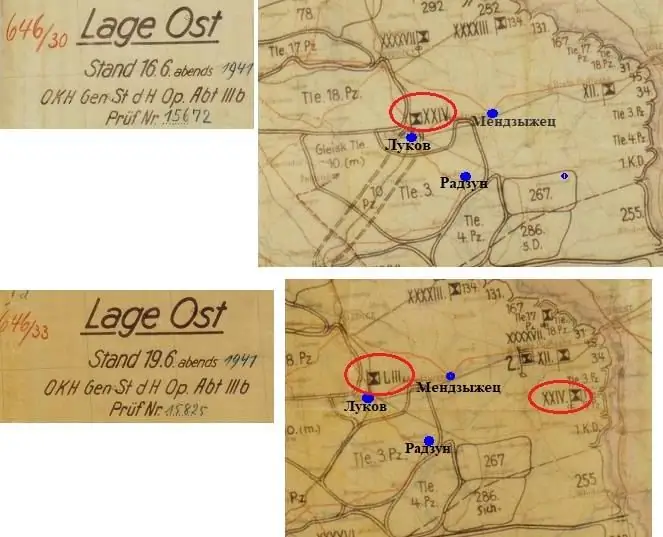
In the city of Lukovo on the evening of 16.6.41 there was not just the headquarters of the corps, but the headquarters of the 24th mk, which on June 19 is already at the border. On the evening of June 19, the headquarters of the 53rd AK is stationed in Lukovo. Corps headquarters were located in the indicated city, but neither intelligence nor radio intelligence could detect their replacement and the movement of MK closer to the border.
In the city of Mezhirechye (Miedzyzhets) from June 16 to June 20, there were no permanent corps headquarters, except for those moving to the border. Somewhere in the period from June 18-19, the headquarters of the 2nd TGR passed through the city. On June 20, the headquarters of the 4th A was located in the city. The reconnaissance did not detect the movements of the headquarters of the 2nd TGr and 4th A to the border.
According to radio intelligence, in the area of Warsaw there are two radio stations that maintain communication with Berlin. Of the large radio stations in this region, one can speak only of the stations in the headquarters of the 4th A and 2nd TGr. The headquarters of the 2nd TGr before the start of the war was not discovered by the intelligence services, as was the large headquarters of the mobile group. The number of the headquarters of the 4th A is confused with the headquarters of the 8th A. The headquarters of the 8th A has long been featured in the many times rechecked RM, although since the fall of 1939 it has not existed. But someone constantly lights it up. Otherwise, the information about the exact number of the army cannot be explained … Also mistakenly, intelligence is tracking the mythical and only headquarters of the front in the East - the headquarters of the Eastern Group. However, this headquarters no longer commands the troops in the East since September 1940. This was also misinformation …
conclusions
The following conclusions can be drawn.
1. The leadership of the spacecraft and the military demanded information on the presence and location of large headquarters.
This is evidenced by a special message from RU shortly before the start of the war:.
General Vladimirov directly reproaches intelligence that the 1st TGr was not found:.
Similar words are reflected in the memoirs of Marshal Baghramyan, head of the KOVO Operations Department:
The former head of RU after the war cites as a merit of intelligence:.
We analyzed in detail the above summary and some other RMs. For the most part, this information turned out to be unreliable …
2. The scouts tried to get RM at any cost, but the massive German disinformation at all levels and through many countries did not allow to reliably determine the places of concentration of German troops and large headquarters, as well as their exit from the depths directly to the border.
At the headquarters of PribOVO, KOVO and ZAPOVO, until June 21, they were sure that most of the German troops were located far enough from the border. This is evidenced by the maps of the headquarters of all three districts and intelligence reports of the RO PribOVO dated June 17 and 21, 1941. In KOVO, the movement of German troops was associated with the expected exercises. The ZAPOVO managed to open the approach of the German troops, but the commander of the district followed the instructions from Moscow in a disciplined manner. Misinformation about the expected exercises of the German troops also came through other intelligence services.
Special message of the NKGB (20.6.41):
3. One of the most unpleasant mistakes of reconnaissance was not detecting enemy mobile groups: TGr and MK. Without the presence of such groups, the German command could not start a war. Otherwise, the blitzkrieg could have given up …
In the second part of the article, it was shown that the intelligence data on the presence of tank divisions were unreliable. For example, in three places in which, according to reliable data, there were three etc., they were simply not there until the end of May 1941. In the spring, an article will be presented on intelligence data regarding German mobile troops: cavalry, motorized and tank forces.






